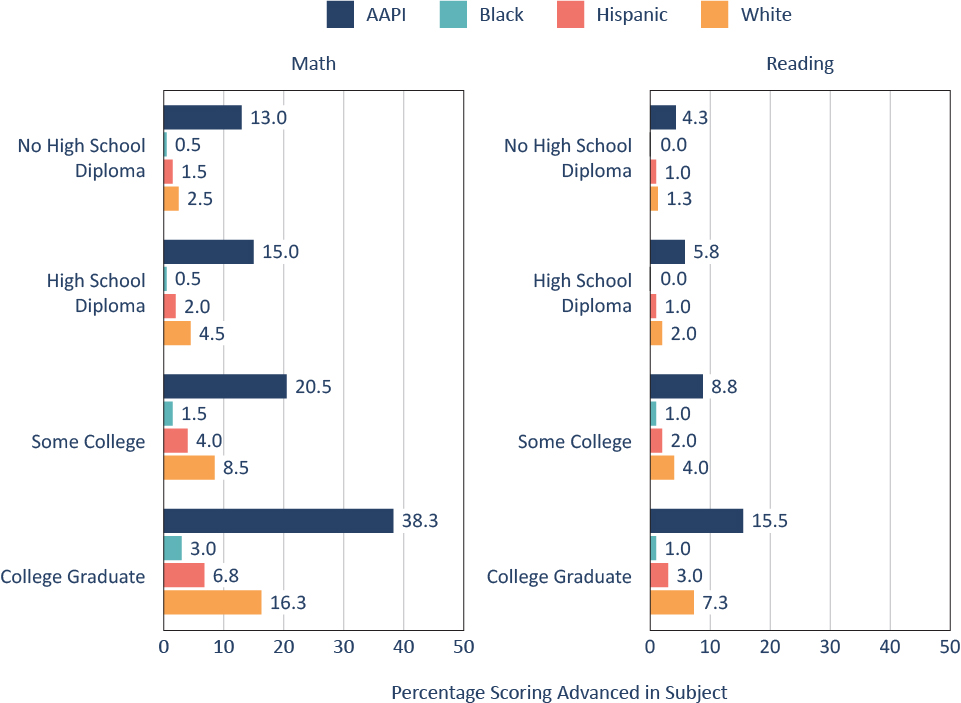This is the fourth in a series on doing educational equity right. See the introductory post, as well as ones on school finance, student discipline, school closures, homework, grading, effective teachers, and a concluding post on doing educational equity wrong.
On my more optimistic days, I think that finding a durable consensus around advanced education—gifted-and-talented programs in elementary schools, advanced courses in middle and high schools, etc.—should be relatively easy. It even fits on a (mega) bumper sticker. “Advanced education: Don’t end it, mend it, and extend it to many more students.”
In other words, if the problem is that gifted-and-talented programs and access to advanced courses have been inequitable in the past—as they surely have been in most places—the solution is not to get rid of them, as some on the far left propose, but to open them up to many more students, especially those from underrepresented groups. Indeed, that’s a decent summary of the recommendations from the National Working Group on Advanced Education, which those of us at the Thomas B. Fordham Institute were honored to convene last year.
But I know that the ideological battles are much sharper than this obvious compromise might let on. Indeed, advanced education is at the heart of the culture wars still raging around DEI, “wokeism,” and the very nature of “merit” in our knowledge-based capitalist economy.
The view from the left
Among many progressives we can detect much skepticism about the very nature of academic “giftedness.” Partly that’s because of the problematic history of the gifted-and-talented movement, linked as it was with some terrible ideologues, including people espousing eugenics and white supremacy. Nor does it help that in some communities, White parents used entrance into gifted-and-talented programs as a way to shield their children from school desegregation efforts.
But even if we’ve moved past all that, it remains a fact that Black, Hispanic, and low-income students are significantly underrepresented in gifted-and-talented programs and advanced courses. If “talent is equally distributed, but opportunity is not,” as a favored slogan goes, clearly these programs must be at odds with opportunity. High achievement is not about “merit,” then, so much as it’s about privilege.
The view from the right
Meanwhile, many of us conservatives tend to take an absolutist position when it comes to merit and achievement. We insist that considering someone’s racial or class identity is (or certainly should be) irrelevant whether we’re talking about selection into gifted-and-talented programs at age five or entrance to selective universities at age eighteen. Everyone should be judged as individuals, and if we see disparities by race or class, that’s just the way the cookie crumbles. We shouldn’t be surprised that children with two well-educated parents do better in school and on achievement tests than those growing up in unstable single-parent homes. Furthermore, it’s not schools’ job to level the economic playing field, but to help every student fulfill their God-given potential. The more kids learn, the more our future economy will grow, and the more secure our nation will be.
Bridging the divide
It’s looking as if the two extremes are quite far apart. Is high academic achievement a sign of merit or privilege? Are kids of color underrepresented in gifted programs and advanced courses because of differences in wealth and family structure or because of exclusion and discrimination?
Let’s see if the three rules that have guided our discussion during this series are helpful here, too:
- When aiming for equity, we should level up instead of leveling down.
- We should focus on closing gaps between affluent students and their disadvantaged peers, not between high-achieving students and their lower-achieving peers.
- We should focus equity initiatives primarily on class, not race.
Rule number one is easy to apply here. Eliminating gifted-and-talented programs, advanced courses, and other forms of “tracking” is clearly an example of leveling down. It’s the Harrison Bergeron strategy of kneecapping talented kids, supposedly for the good of the whole. It’s not only morally repugnant, but politically unsustainable.
To level up instead of down, we need to embrace acceleration for kids who are well over on the right side of the achievement distribution, while also erring on the side of inclusion. One of the best ways of doing so is using so-called “local norms.” That means selecting, say, the top 10 percent of students in every elementary school and inviting them into gifted-and-talented programs and acceleration opportunities, rather than the top 10 percent of students in the whole district or the whole state. That would ensure that students at every school in America, including high-poverty schools, would gain access to such opportunities—and boost the number of low-income kids and kids of color who end up participating. Schools and districts should also avoid selection factors that can introduce racial or socioeconomic bias, such as mandatory recommendations from teachers or parents. Instead, “universal screening” should identify all students who could benefit from greater challenge, who should be placed into advanced learning as the default.
Rules number one and two also mean making sure that the students who don’t get into gifted-and-talented programs or advanced courses are also held to reasonably high standards. The detracking people weren’t wrong that the old remedial tracks were tracks to nowhere and hotbeds of the “soft bigotry of low expectations.” We surely don’t want to go back to that. Nor should placement into a track or ability group be set in stone; the spirit of “universal screening” for advanced learning opportunities only works if we keep doing it rather than think of it as “one and done.”
Our rule number three—focus primarily on class instead of race when seeking to do educational equity right—is probably the most challenging here. While it’s true that controlling for socioeconomic factors significantly reduces the “excellence gaps” among races, it doesn’t completely eliminate them. That was one finding of a recent study by my colleagues Adam Tyner and Meredith Coffey. What’s particularly perplexing is the low percentage of Black students who are achieving at the highest levels on standardized tests—even Black students from high-SES families.
Figure 1. Excellence gaps by race/ethnicity persist within student socioeconomic groups, as measured by the mother’s education level.

We’re not the first ones to uncover this finding—far from it. Indeed, decades of scholarship have examined the relative underperformance of Black students in affluent communities, such as Shaker Heights, Ohio, outside Cleveland. This was also the subject of a recent book by the Washington Post’s Laura Meckler. Perhaps it’s a statistical artifact—maybe Black students in such neighborhoods are more disadvantaged economically than they appear via rudimentary data. But there’s reason to suspect that it goes deeper. One prominent theory—which, no, hasn’t been debunked—is the “acting White” phenomenon, born out of the aftermath of desegregation, in which some Black students fear paying a social price for excelling academically. Creating a “culture of high achievement,” as many of the best charter schools do, may be the most promising way to meet the challenge, though in integrated schools, it might be hard to do so entirely via race-neutral means.
—
I think it’s fair to say that the right is naturally more comfortable with meritocracy in general, and advanced education in particular, than the left is. If we conservatives want our fellow citizens across the ideological spectrum to embrace advanced learning, too, we need to take their equity concerns seriously. That means working harder and smarter than we have in the past to ensure that gifted-and-talented programs and advanced courses are not the exclusive province of affluent students, most of them White or Asian. We don’t have to embrace the whole DEI ideology or eliminate entrance standards to gifted programs or advanced courses to acknowledge that our advanced learning opportunities could and should be more diverse, equitable, and inclusive. Say it with me: Don’t end it, mend it, and extend it!




